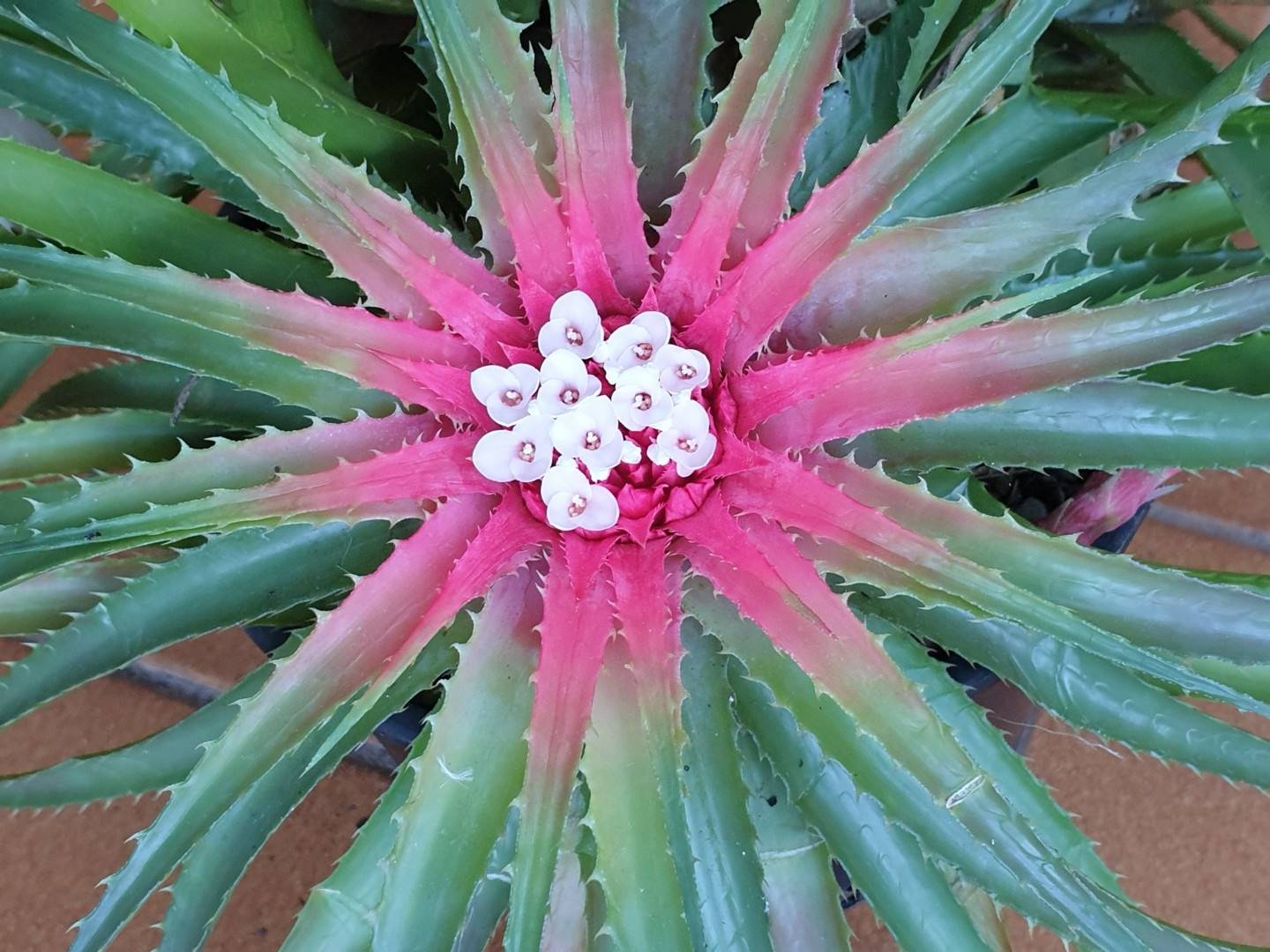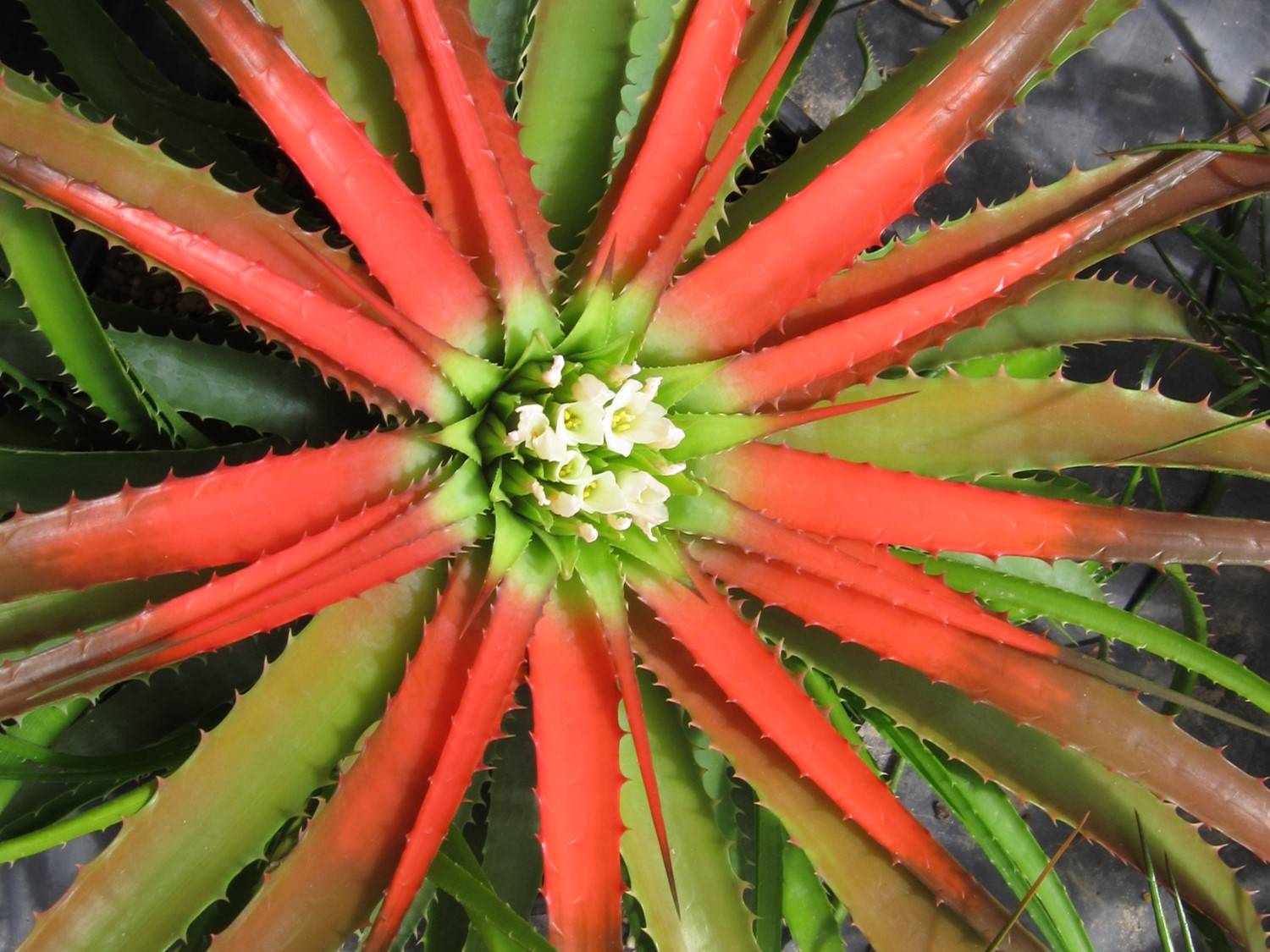


Orthophytum hatschbachii Leme Selbyana 16(10: 110-122. 1995
Type. Brazil: Bahia State, Rio de Contas; 1,300 m, April 7, 1992, G. Hatschbach 56827, M. Hatschbach & E. Barbosa (MBM, holotype).
A 0. amoenum (Ule) L.B.Smith, cui affinis, foliis 20-30 cm longis, laminis foliorum spinis 0.5-1.5 mm longis, bracteis involucratis perminute sed subdense spinulosis, inflorescentia ca. 3 cm diameter, petalis basi ligulis subintegris differt.
PLANT saxicolous, nearly stemless.
LEAVES ca. 60 in number, spreading, forming a very dense round rosette;
LEAF SHEATHS inconspicuous but broader than the blades, sub-entire to spinulose toward the apex;
BLADES narrowly sublinear-triangulate, long acuminate-caudate, 20-30 cm long, ca 1.2 cm at base, glabrous, strongly nervate, margins laxly serrulate, spines subspreading, 0.5-1.5 mm long.
INFLORESCENCE pseudosimple, sessile, many-flowered, ca. 3 cm in diameter;
INVOLUCRAL BRACTS triangulate, very minutely but subdensely spinulose;
FLORAL BRACTS oval-triangulate to triangulate, acute, subentire to inconspicuously spinulose, ecarinate, glabrous, 11 x 5-10 mm;
FLOWERS ca. 13 mm long (excluding the petals), very densely arranged;
SEPALS ovate, acute, 8 x 5 mm, free, entire, glabrous, the posterior ones alate-carinate;
PETALS known only from fragments, free, bearing two subentire appendages 4 mm above the base;
OVARY ca. 3 mm long; Epigynous tube lacking; Placentae apical;
OVULES few; seeds obtuse, ca. 1mm long, finely nerved.
This species is similar to 0. amoenum but differs by the distinctly longer leaves (20-30 cm long), leaf-blades with 0.5-1.5 mm long spines, involucral bracts minutely but subdensely spinulose, inflorescence ca. 3 cm in diameter, and petals bearing subentire appendages at base. The 0. hatschbachii is named after its collector, Gert Hatschbach, Director of the Museu Botanico Municipal de Curitiba, Parana State, who has added several new records to the bromeliad flora of Brazil.
Notes from Louzada Thesis 2008
Distribution and habitat: BRAZIL. Bahia: Rio de Contas and Abaira. It inhabits campos rupestris, always occurring in xeric environments, on rocks exposed to high light intensity and the edge of river rapids.
Phenology: Found with flowers from October to March.
Specimens examined: BRASIL. BAHIA: ABAIRA, Catoles de Cima, 25.xii.1992, Harley et al. 50366 (SP); Cabaceira, Riacho Fundo, 25.x.l993, Ganev 2314 (HUEFS); RIO DE CONTAS, Estrada Real, 3.iii.2002, Souza & Konno 503 (SP); Brumadinho, 2l.xii. 2006, Louzada & Moreira 59 (SP); Fazenda Brumadinho, 5.xi.1988, Wanderley & Kral 1532 (SP); Mato Grosso, 25.xii.2004, Forzza & Silva 3825 (RB); Pico das Almas, 14.xii.1984, Arraes et al. CFCR 6917 (RB); 30.x.1988, Harley et al. 25779 (SP, CEPEC); 20.xi.1988, Harley et al. 26225 (SP, CEPEC); 22.i.1974, Harley 15413 (CEPEC).
Orthophytum hatschbachii is morphologically related to O. burle-marxii and O. heleniceae, differing from O. burle-marxii by having a simple inflorescence (vs. compound); petal appendages to 4 mm from the base of petals (vs. 7 mm); leaf blade green at base (vs. red); bracts and sepals green (vs. red). Orthophytum heleniceae and O. hatschbachii can be confused on first examination by the colouration of its leaves and bracts, however they are easily distinguished by the margin of the leaf blades, being spinescent in O. hatschbachii and serrated in O. heleniceae. Besides the size of the spines, the branching or not of the inflorescence and presence or absence of capitate trichomes are features that aid in identification of the two species. In O. hatschbachii the spines are larger (2-3.5 mm long), the simple inflorescence and floral bracts, sepals and petals not with capitate trichomes, differing from O. heleniceae whose apines are smaller (0.5 mm length), with a compound inflorescence and capitate trichomes on the floral parts.
The geographical distribution of Orthophytum hatschbachii, O. heleniceae and O. burle-marxii shows the different areas of occurrence of these three species, each being referred to only one or at maximum, two adjacent municipalities, but with obvious geographical barriers. Orthophytum hatschbachii is known from the municipality of Rio de Contas and the neighboring municipality Abaira, O. heleniceae is referred only to the municipality of Andarai, geographically separated from the earlier species by the Serra do Sincora and O. burle-marxii, is known, up to the moment, in the municipalities of Lencois and Morro do Chapeu, located in the northern part of the Chapada Diamantina.
Doug Binns, Hi Ross
As you should! I certainly wouldn't rely on what I've said!
In this case, I think Derek's files on these couple of species may be out of date. I've been relying on Louzada and Wanderleys 2010 revision, but apart from their interpretation, I acknowledge that it is hard to know what O. amoenum really is, because the type location is very generalised and could be anywhere within a 50 km (or more) radius and the original description is not adequate to distinguish it from similar species described subsequently. So, I've just accepted their concept of O. amoenum, right or wrong (but presumably they have at least seen the type so are in a better position than most to make a judgement).
According to L&W, O. hatschbachii has green bracts and sepals, while O. amoenum (as interpreted by L&W) has red or pink bracts and sepals. I've seen and photographed plants from close to the locality they give for O. amoenum which closely match their description. These plants are quite distinctive, with short, broad and thick leaves. The plant I left with you is from seeds from very close to the type locality of O. hatschbachii and matches the description by L&W, which is why I've been calling it that. The original description by Leme doesn't mention colours (presumably because he never saw live plants), but he does give a locality and there do not appear to be any other species of sessile Orthophytums growing in that area.
If we accept the 2010 revision, I think only two of Derek's images of O. amoenum are possibly that species, the ones called 'Ortho amoenum Oscar' and 'Ortho amoenum Oscar-2'. I'm not sure though, because the leaves are unusually long, thin and numerous for O. amoenum as interpreted by L&W, so the images could be another species. The others labelled O. amoenum are possibly a form of O. heleniceae. I notice most are date-stamped 2002, which predates the 2004 description of O. heleniceae, so perhaps they just weren't updated. Derek's images of O. hatschbachii are possibly O. ophiuroides. These sessile Orthophytums can be hard to identify from images of single plants because in nature they are extremely variable in leaf characteristics.
There's been a lot of confusion over these small sessile Orthophytums and even with all the recently described species, I think we haven't heard the last about them. I'm sure there are still undescribed species out there, because the habitat doesn't seem to have been thoroughly explored.
Thanks for checking. I think we need to be always checking to make sure we have it right (or as best as we can with the often inadequate older descriptions). I feel fairly confident I got this one right, but I'm always open to being corrected! Let me know if you find out anything more.
Regards, Doug
From Derek Butcher:
Ross:
Interesting. Different answer to what I expected. In the protologue for hatschbachii it says leaves longer than amoena. I didn't go into sepal colour.
I have always followed Rafael Louzada even from his pre-graduate days and have even helped him with translations to English. I even backed him when he disagreed with some of Leme's findings. Doug has come up with some interesting findings which I think should be discussed with the Brazilians. Could you do a pdf of Doug's article so I can get some comment from Rafael.
I am also intrigued about Oscar's 2002 photos of amoena because that was the time that Oscar was overjoyed that Elton was going to name an Orthophytum after his wife Helenice. So Oscar clearly knew the difference between amoena and the new species he had found. In fact Oscar seems to spend at least once a year roaming this area and finding new challenges for Brazilian Botanists.
Some of Doug's queries may well be already on the drawing board. There is also a hint of a new genus name for this group.
Derek